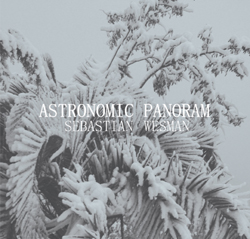|
luscinia DISCOS |
||
| lus_2 |
Sebastian Wesman Astronomic Panoram |
|
|
9 €
OTROS MÉTODOS DE PAGO ENVÍOS CERTIFICADOS escriba a luscinia.discos@gmail.com
A LA VENTA TAMBIÉN en GRANADA (España): SUBTERRÁNEA COMICS DISCOS c/ Horno de Abad, 12 (frente a Sala Planta Baja) subterraneacomics.blogspot.com & TALLIN (Estonia):
|
Primer disco del compositor multinstrumentista de origen argentino y residente en Estonia Sebastian Wesman bajo esta firma. Con anterioridad estaba involucrado en su -también personal- proyecto Isabelasnacho, con el que ha publicado dos álbumes. Astronomic Panoram ha sido grabado con una notable variedad de instrumentos musicales clásicos y diversidad de músicos participantes. Tiene importantes reflejos de la música del compositor estoniano Arvo Pärt, en las melodías, las texturas y las emociones. Pero también es una música hondamente estoniana por la influencia de la tradición y, en otra índole, porque su sonido peculiar nos arropa en paisajes característicos del norte, nevados, que absorben, amortiguan y empapan de silencio. El propio Sebastian Wesman se encarga de tocar el violín, la viola, el piano, las flautas, los timbales y de aportar, de forma particular y puntual, su voz; Martin-Eero Köressaar toca la tuba y la trompeta; Mai Nuudi ofrece su voz de soprano; la poeta Diana Norma Szokolyai interpreta, entrelazada con el violín de Wesman, su poesía "Underground Rivers"; y Anneli Köressaar hace un recitado, también poético, en esa lengua que nos puede resultar tan extraña, por poco corriente, pero tan arraigada que es el estoniano. Retratan entre todos un mundo fantástico, casi cinematográfico (otra de las grandes dedicaciones artísticas de Wesman a día de hoy), de sueños, recuerdos y emociones insondables, donde el movimiento es sentido, tocado y respirado. La pieza "Lágrimas" ha formado parte de la BSO de la película Póra de Raul Perrone. |
|
|
Poemas de Diana Norma y Sebastian Wesman
Masterización de Tarmo Pajusaar
Primera edición: Arte gráfico de Sebastian Wesman Febrero de 2011 agotada
Segunda edición: Arte gráfico de Sarah Vacher Enero de 2012 agotada
Tercera edición: Arte gráfico de Sarah Vacher Junio de 2015
Entrevistas:
Histéricas Grabaciones 18/8/2015: "Entrevista a Sebastian Wesman" "Showcase: Sebastian Wesman" "Los parámetros de Wesman" "Cantos azules"
|
||
|
Críticas |
||
|
"
/ Modern Composition / — — " Je zal me in dit Schaduwkabinet niet zo snel betrappen op recensies van oude werken, zij het als het gaat om bepaalde parels waar je niet omheen kunt of heruitgaven. De cd Astronomic Panoram (astronomisch panorama) van de in Estland woonachtige Argentijnse (ja verzin het maar) componist en multi-instrumentalist heeft beide. Het werk van Wesman (ook opererend onder de naam Isabelasnacho) is oorspronkelijk begin 2012 uitgegeven op het kleine Spaanse kwaliteitslabel Luscinia. Wesman draagt zorg voor de composities en de instrumentale bijdragen op viool, altviool, piano, zang, fluiten, pauken, elektronica en veldopnames. Hij krijgt hulp van de sopraan Mai Nuudi, tubaspeler/trompettist Martin-Eero Kõressaar en spoken word van Diana Norma en Anneli Kõressaar. De cd opent met door blazers gestuurd neoklassiek, die een spannende, tijdloze serie als “De Wrekers” lijkt in te luiden. Maar dan begint Wesman te spelen met de compositie, veelal met elektronica dan wel bijzondere instrumentale inbreng, die nog altijd tijdloos blijft klinken, maar een moderne wending krijgt. Telkens legt hij de accenten net anders, van intrigerend filmisch en desolaat elektro-akoestisch materiaal tot meer poëtische folkachtige, Barokke en klassiek getinte stukken, al dan niet aangevuld met de samples. En soms loopt alles door elkaar. Er zit een prettige ambivalentie in het album, waarbij de muziek eigenlijk zonder uitzondering adembenemend mooi is. Zo laveert hij van Nils Økland, Zbigniew Preisner, Philip Glass en Hilmar Örn Hilmarsson naar Owain Phyfe, L’Arpeggiata en Benjamin Britten. Dit geweldige meesterwerk is nu voor de derde keer uitgebracht. En terecht! " (Jan Willem Broek, De Subjectivisten, 21/7/2015) — —
" o
believe this is indeed a small ensemble of some kind, mainly in the recording.
As I mentioned before I am hardly trained to write about modern classical music
- be it the hard way of strange, abstract music, or, and that's the case here,
of a more melodic kind. I do know, however, that I quite enjoyed this. In all
its modern approach, the music still has that 'old' quality to it. Although I
might be entirely wrong, there is a certain quality to this which reminded me of
the few works I heard of Arvo Part, but then captured within the limits of a pop
song. Eight pieces in under thirty minutes. Dramatic, but not in a pathetic way,
melodic, but not in a cliche like manner, and simply quite nice altogether. Less
'radio play' like, but simply great music, and still wondering why what the hell
is this?
|
||
